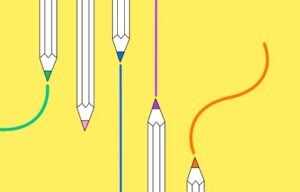Inspiration for Graphic Designers: Creativity in Your Design Projects
Graphic design is a dynamic field that combines creativity with strategic thinking to communicate ideas visually. For graphic designers, finding inspiration is crucial to producing innovative and effective designs. This article explores various sources of inspiration, techniques for sparking creativity, and tips for maintaining a steady flow of fresh ideas for your design projects.

Sources of Inspiration for Graphic Designers
Inspiration can come from many places. Whether you’re working on a brand identity, a marketing campaign, or a personal project, exploring diverse sources can help you discover new ideas and approaches.
1. Nature and the Environment
Nature is an abundant source of inspiration for graphic designers. The colors, shapes, and patterns found in natural environments can inspire everything from color palettes to layout designs. Take a walk in the park, observe the changing seasons, or explore natural landscapes to gather visual ideas. Natural textures, such as the grain of wood or the surface of a leaf, can also provide unique design elements.
2. Art and Design History
Exploring historical art movements and design trends can offer valuable insights into different styles and techniques. Look into periods like the Bauhaus, Art Deco, or Pop Art for inspiration. Museums, art galleries, and online archives are excellent resources for discovering influential works from the past. Studying historical designs can help you understand the evolution of graphic design and inspire your own creative processes.
3. Contemporary Design Trends
Staying updated with current design trends can provide fresh ideas and help you keep your work relevant. Websites like Behance, Dribbble, and Design Milk showcase the latest design trends and innovative projects from designers worldwide. Analyzing these trends can inspire new approaches and techniques for your own designs.
4. Books and Magazines
Design books and magazines offer a wealth of inspiration through case studies, interviews, and showcase sections. Publications like Communication Arts, Eye Magazine, and Print provide insights into successful design projects and feature the work of leading designers. Reading these resources can spark ideas and offer new perspectives on your own projects.
5. Online Communities and Social Media
Social media platforms and online communities are great places to find inspiration and connect with other designers. Follow design accounts on Instagram, join design-focused groups on Facebook, or participate in design challenges on Twitter. Engaging with these communities can expose you to diverse ideas and feedback.
6. Everyday Objects and Experiences
Sometimes inspiration is right in front of you. Pay attention to everyday objects, experiences, and environments. The design of everyday items like packaging, signage, and products can provide ideas for new projects. Observing how people interact with these objects can also give you insights into effective design strategies.
7. Travel and Cultural Exploration
Traveling exposes you to different cultures, design aesthetics, and architectural styles. Whether you visit a new city or explore local neighborhoods, traveling can broaden your design perspective. Pay attention to local art, architecture, and design elements to inspire your own work.
8. Creative Workshops and Conferences
Participating in workshops and attending design conferences can be a great way to find inspiration and learn new techniques. These events offer opportunities to meet other designers, explore new tools, and hear from industry experts. Workshops and conferences can provide fresh perspectives and practical advice for your design projects.
Techniques for Sparking Creativity
Finding inspiration is just the beginning. Once you have gathered ideas, using techniques to spark creativity can help you develop those ideas into successful designs.
1. Mind Mapping
Mind mapping is a technique for visually organizing information and ideas. Start with a central concept and branch out into related thoughts, images, and keywords. This technique can help you explore different aspects of your project and generate new design ideas.
2. Sketching and Doodling
Sketching and doodling are powerful tools for brainstorming and refining design concepts. Allow yourself to create freely without worrying about perfection. Sketching can help you explore different design solutions and find new ways to express your ideas.
3. Creative Constraints
Setting creative constraints can encourage innovative thinking. Limit your color palette, restrict your use of certain design elements, or challenge yourself with a specific theme. Constraints can push you to think outside the box and find creative solutions to design problems.
4. Collaborating with Others
Collaborating with other designers or creative professionals can bring new perspectives and ideas to your projects. Brainstorming sessions, design critiques, and collaborative projects can help you explore different approaches and improve your design work.
5. Taking Breaks and Seeking Inspiration Outside Design
Sometimes stepping away from design work can lead to new insights. Engage in hobbies, exercise, or spend time with friends and family. These activities can refresh your mind and provide new sources of inspiration.
Tips for Maintaining a Steady Flow of Inspiration
Maintaining a steady flow of inspiration can be challenging. Here are some tips to help you stay creatively motivated throughout your design career.
1. Create an Inspiration Board
An inspiration board is a collection of images, quotes, and ideas that inspire you. Keep a physical or digital board where you can gather and organize your sources of inspiration. Regularly updating your board can help you stay motivated and focused on your design goals.
2. Set Aside Time for Creative Exploration
Dedicate time each week for creative exploration and personal projects. This time allows you to experiment with new techniques, explore different design styles, and work on projects that interest you. Creative exploration can lead to new ideas and prevent burnout.
3. Seek Feedback and Critique
Getting feedback from others can offer new perspectives on your work and inspire new ideas. Share your designs with colleagues, mentors, or online communities and be open to constructive criticism. Feedback can help you refine your designs and discover new creative directions.
4. Keep a Design Journal
A design journal is a personal space for jotting down ideas, sketching, and reflecting on your creative process. Regularly writing in your journal can help you track your progress, identify patterns in your thinking, and develop new design concepts.
Conclusion
Inspiration for graphic designers comes from a variety of sources, including nature, history, contemporary trends, and personal experiences. By exploring these sources and using techniques to spark creativity, you can generate innovative ideas and maintain a steady flow of inspiration for your design projects. Remember to stay curious, experiment with new approaches, and seek out opportunities for creative growth. With these strategies, you can continue to produce engaging and impactful designs throughout your career.



